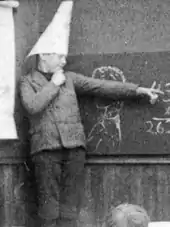Dunce
A dunce is a person considered incapable of learning. Dunces are often comedically shown wearing paper cone hats, known as dunce caps with the word "dunce" or "dumb", or simply a capital D, on them. Schoolchildren were sometimes compelled to wear a dunce cap and to stand or sit on a stool in the corner as a form of punishment for misbehaving or for failing to demonstrate that they had properly performed their studies.
Origins
The word is derived from the name of the Scottish Scholastic theologian and philosopher John Duns Scotus.[1] Along with Thomas Aquinas and William of Ockham, he was one of the leading Scholastic philosopher-theologians of the High Middle Ages. Duns Scotus wrote treatises on theology, grammar, logic and metaphysics, which were widely influential throughout Western Europe, earning Duns the papal accolade Doctor Subtilis (Subtle Teacher). Duns remains highly esteemed in the Roman Catholic Church, and was beatified by Pope John Paul II in 1993.
The followers of Duns Scotus were called the Dunses, Dunsmen, or Scotists.[2] When in the sixteenth century the Scotists argued against Renaissance humanism, the term duns or dunce became, in the mouths of the Protestants, a term of abuse and a synonym for one incapable of scholarship.[3] This was the etymology given by Richard Stanyhurst. Samuel Johnson, on the other hand, maintained that the source of the word was unknown.
Dunce cap

A dunce cap, also variously known as a dunce hat, dunce's cap or dunce's hat, is a pointed hat, formerly used as an article of discipline in schools in Europe and the United States.[4][5] In popular culture, it is typically made of paper and often marked with a D or the word "dunce", and given to unruly schoolchildren to wear. Frequently the "dunce" was made to stand in the corner, facing the wall. The hope was that no one would want to be labelled the "dunce" in the class, even for a short period of time, and thus students would avoid misbehaviour. Examples of behaviour which could warrant the dunce cap included throwing spitballs, passing notes, or pulling of hair. Class clowns were frequently admonished with the dunce cap.
In modern pedagogy, punishments like dunce caps have fallen out of favor.[6]
According to The Straight Dope, Duns Scotus recommended the wearing of conical hats to stimulate the brain – so-called "thinking caps".[7] (This notion is the likely source of the pointed hats traditionally worn by wizards, etc.) However, the Oxford English Dictionary (2nd edition) records that the term "dunce cap" itself did not enter the English language until after the term "dunce" had become a synonym for "fool" or "dimwit". In fact, "dunce cap" is not recorded before the 1833 travel book America, and the Americans by James Boardman. [8] John Ford's 1624 play The Sun's Darling is the first recorded mention of the related term "dunce table," a table provided for duller or poorer students.
On the TV game show Win Ben Stein's Money, a player who answered in the form of a question (as required on the game show Jeopardy!) was required to wear a dunce cap.
Literary dunce
A literary dunce is a person, either real or fictional, who is used in literature as a target of satire. This usage of the term derives from Alexander Pope's landmark poetic satire The Dunciad. Dunces are not villains, although they can be villainous, as much as they are held up as the epitome of stupidity, imposture, and connivance.
See also
Notes
- Jeaffreson, John Cordy (1870). A Book About Clergy. Hurst and Blackett. p. 81. ISBN 9780598437297.
- "dunce, n." OED Online. Oxford University Press, June 2017. Web.
-
 One or more of the preceding sentences incorporates text from a publication now in the public domain: Chisholm, Hugh, ed. (1911). "Dunce". Encyclopædia Britannica. 8 (11th ed.). Cambridge University Press. p. 671.
One or more of the preceding sentences incorporates text from a publication now in the public domain: Chisholm, Hugh, ed. (1911). "Dunce". Encyclopædia Britannica. 8 (11th ed.). Cambridge University Press. p. 671. - Chico, Beverly (3 October 2013). "The Dunce Cap". Hats and Headwear around the World: A Cultural Encyclopaedia. ABC-CLIO. p. 116. ISBN 978-1-61069-063-8.
- Grundhauser, Eric (10 September 2015). "The Dunce Cap Wasn't Always So Stupid". Atlas Obscura. Retrieved 1 September 2018.
- Ryback, David (1993). "Eastern Sources of Invitational Education". Journal of Invitational Theory and Practice. Atlanta, Georgia. 2 (2): 79.
- Gaudere (21 June 2000). "What's the origin of the dunce cap?". The Straight Dope. Retrieved 6 April 2017.
- Boardman, James (1833). America, and the Americans. London: Longman, Rees, Orme, Brown, Green, & Longman. p. 101.
References
External links
| Wikimedia Commons has media related to Dunce caps. |
- Gaudere (June 2000). "What's the origin of the dunce cap?". The Straight Dope. Retrieved 8 December 2016.
- "Dunce's corner banned - but how did it all start? What's the origin of the dunce cap?". Spd Rdng. January 2010. Retrieved 8 December 2016.